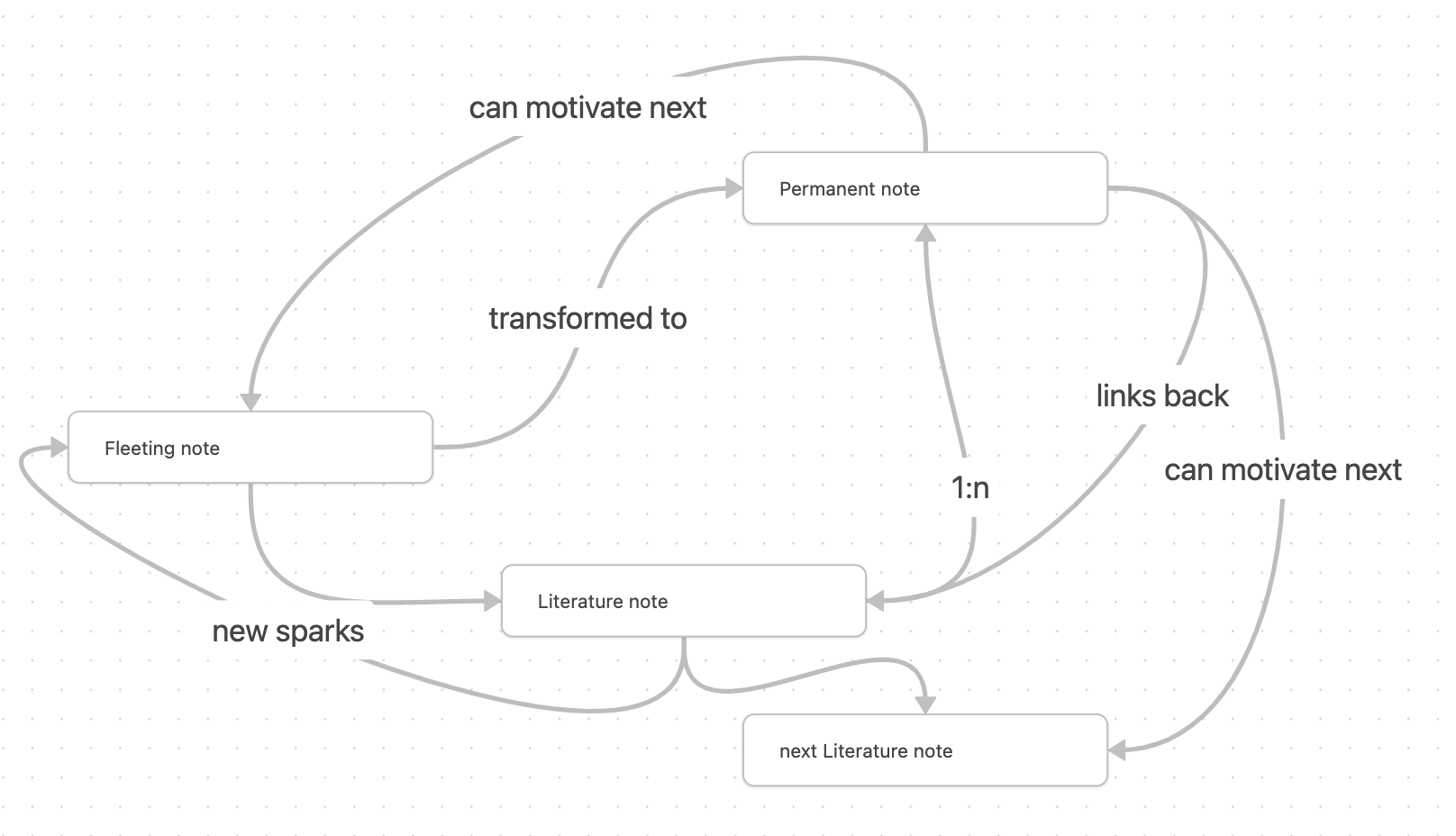About my usage of Fleeting Notes, Permanent notes and Literature Notes
Fleeting notes
Based on How to take Smart Notes - Key Insights a fleeting note is used for temporary notes that I will like trash later. They should be just pointers for following up information, maybe also ToDo lists, more noise level information. Fire and forget would be just fine on this level.
Create them e.g while reading, just 1..2 words when a thought appears.
I use TPL Fleeting Note and best using the command to create a fleeting note from a template.
Storing fleeting notes
Fleeting notes are tagged with #type/fleeting-note
Fleeting notes reside in a folder fleeting notes that resides inside a Zettelkasten folder place area for each space [[S01 Personal/+📥 inbox/Fleeting notes|Fleeting notes]].
Fleeting notes can also be captured inside projects. But I need to further observe if that makes sense.
Permanent notes
Permanent notes (How to take Smart Notes - Key Insights).
And it became obvious that there is a transition from literature notes and derived permanent notes. And there is also a transition from fleeting notes to permanent notes and also to literature notes.
I use TPL Permanent Note and my Obsidian command to create a permanent note from a template.
Storing permanent notes
Permanent notes are tagged with #type/permanent-note
In Permanent notes folder when they don’t have an obvious area to reside in. In an area when they have a strong connect to that area of responsibility.
I need to further monitor if it makes sense to store them in projects too. For now I don’t have strong signals that indicate that this will create a problem.
Permanent notes in Projects
What should happen when I archive a project? I guess I should scan for permanent notes from that project that are worth keeping in areas.
How should I handle permanent notes that belong to several projects?
- Check if it makes sense to move them to an areas
- I should avoid duplicating that knowledge artifact
- In beginning I can just link/embed notes in the relevant context and closely monitor the need for extraction.
Literature notes
I use [[TPL Literature Note]] and my Obsidian command to create a literature note from a template.
Storing of Literature notes
Literature notes are tagged with #type/literature-note
There are different entry points for literature notes but all are stored in [[Literature notes]]
- My [[Literature Inbox]] contains the [[_Reading Order]] Kanban board and book notes created from the Book search plugin
- [[Kindle]] contains all Kindle book highlights by Kindle title. The obsidian Kindle plugin connects to my Amazon account. In Kindle I already do first stage highlighting while reading a book.
- [[Bibs]] contains further condensed versions for Blinkist books in Blinks (BiB). I already applied 1st stage and partially 2nd stage processing. I use the template [[TPL Blink Note]] for starting with this kind of note
The folder [[S01 Personal/030-039 Areas/32 Zettelkasten/Matter/Matter]] contains all notes forwarded from the read later app Matter that I use for capturing Online Articles and 1st stage highlighting.
Index notes
An index note marks note that act as entry point to find other notes. Or like Maps of Content provide a high level intro about a topic and provide possibilities to drill down.
Storing of index notes
Index notes are tagged with #type/index-note.
Maps of Content are a sub type of Index notes. I tag them with #MOC .
Examples for using the different note types
- When I read a book, Bib or article and want to capture highlights - these are initially literature notes. They stem from various sources like:
- books on Kindle
- articles in Matter
- bibs in Blinkist
- pdfs/eBooks from other sources
- When I want to capture a fast thought that I want to process later, then this should become a fleeting note (best also linked for later usage with my journal)
- When I distill information from a literature note I create knowledge artefacts that become permanent notes. In the beginning this permanent note is still in an early stage (see Maturity Model for my Obsidian Notes)
- Is a book note already a literature note? Yes, when I created the books note snippet from the Obsidian book note plugin. No when it is just a thought and I did not yet have time to create a note with more details from it.
Working with note maturity levels
I should for sure apply my maturity levels to my permanent notes. (and change my usage of fleeting notes)
This would still enable an iterative refinement for my permanent notes and evolving them. And when building on it, I can build in a trust layer … like how much I can rely on a note already or where I need more foundational work.
Should I also work with maturity levels for my literature notes?
- Dimensions might have similar names but transition criteria will be different. And maybe it would be even better to have an own naming convention here. For now I’ll use the same maturity system
Note transitions visualized
TODO: Move to Excalidraw as this allows live embedding and converting to a picture.
Snapshot for the moment

Thinking process
- Building a Second Brain - Insights
- I also have a flow from Remarkable to my Obsidian notes. I think I should visualise all paths through CODE
- Where do I store my permanent notes? Especially within PARA